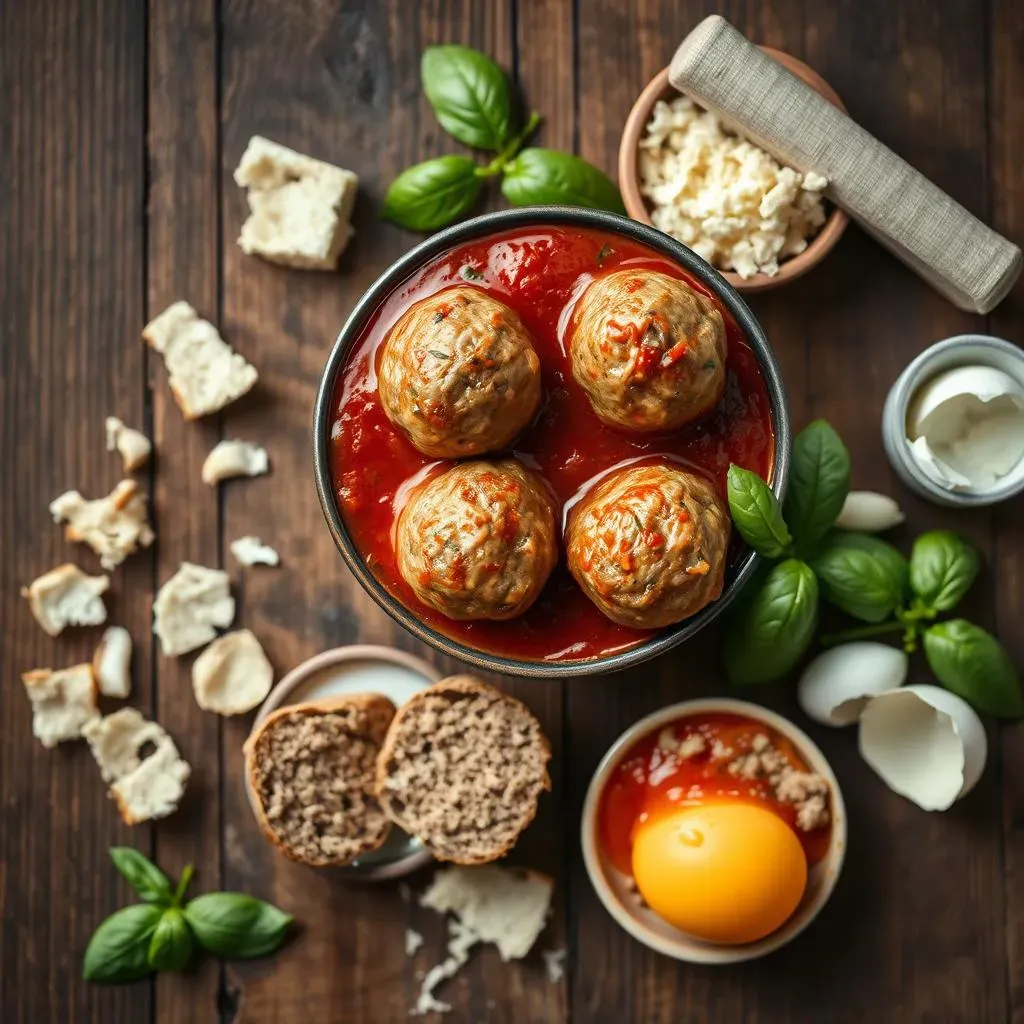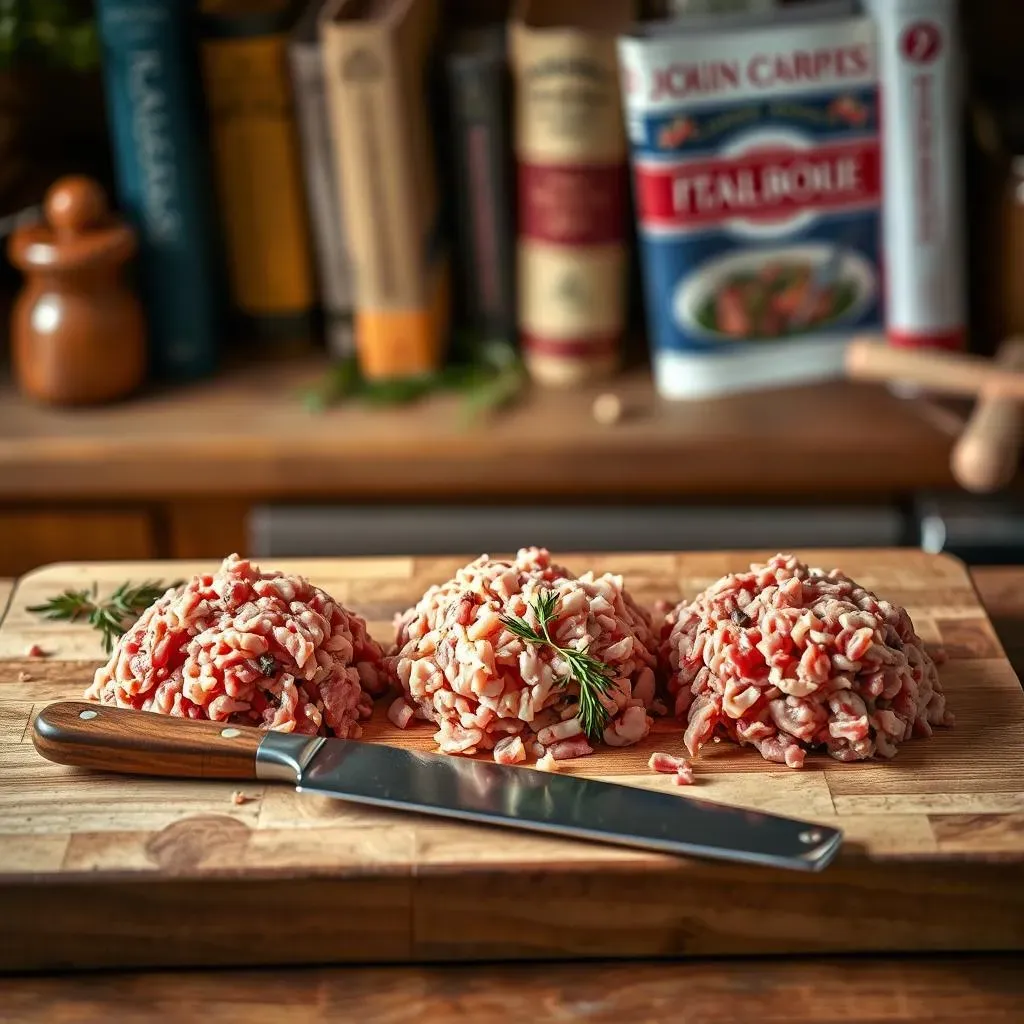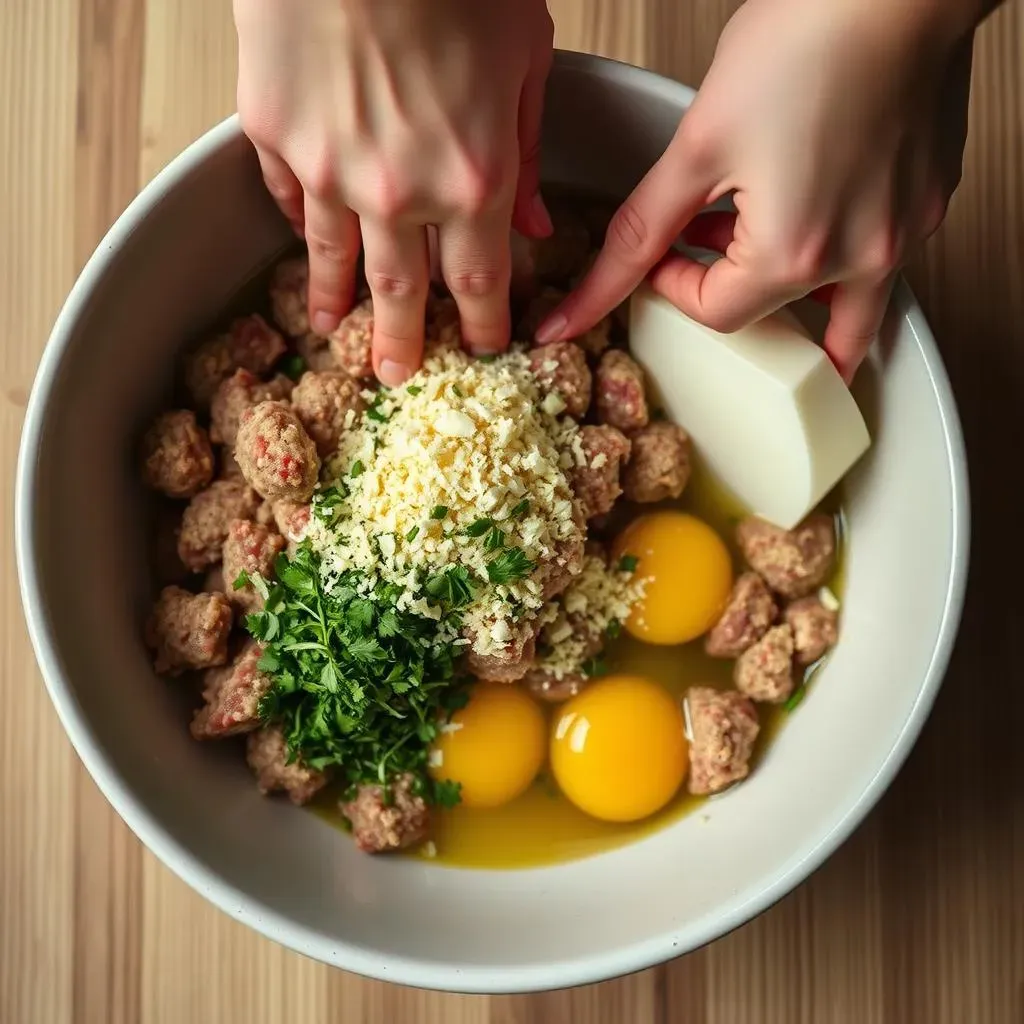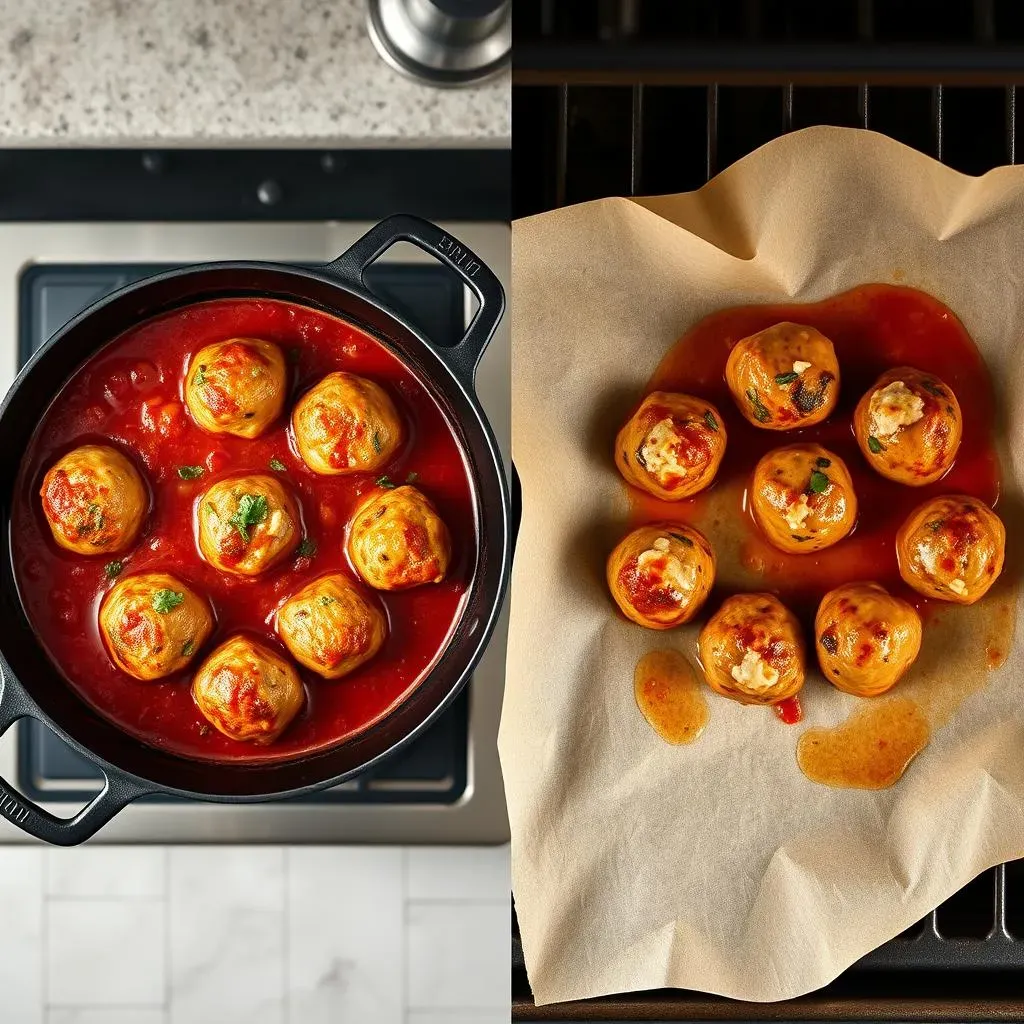Table of Contents
Craving that comforting taste of home? Look no further than the **classic italian meatball recipe**. These aren't your average, dry, hockey-puck meatballs; we're talking about tender, juicy spheres of flavor that practically melt in your mouth. This guide will walk you through every step of creating the perfect batch, from selecting the right meats to mastering the cooking process. We'll explore the secrets to achieving that coveted tenderness, the essential ingredients that make these meatballs truly Italian, and the best cooking methods to ensure they're cooked to perfection. Whether you prefer simmering them in a rich tomato sauce on the stovetop or baking them in the oven, we've got you covered. So, roll up your sleeves, gather your ingredients, and get ready to embark on a culinary journey that will transport you straight to Nonna's kitchen. By the end of this article, you'll have a **classic italian meatball recipe** that will impress your family and friends, and become a staple in your cooking repertoire. Let's get started!
The Secret to Tender and Juicy Classic Italian Meatballs

The Secret to Tender and Juicy Classic Italian Meatballs
The Panade Principle
Alright, listen up, because this is where the magic happens. The real secret to unbelievably tender meatballs lies in something called a "panade." Sounds fancy, right? It's not. All it is is bread soaked in milk. Seriously! This milk-soaked bread adds moisture and prevents the proteins in the meat from tightening up during cooking. Think of it like a built-in insurance policy against dry, tough meatballs.
Now, you can use different types of bread for your panade. Some people swear by crustless white bread, others like Italian bread, and some even use stale bread. The key is to make sure the bread is fully saturated with milk before you mix it into the meat. I usually tear the bread into small pieces, soak it in milk for about 10-15 minutes, and then mash it into a paste with a fork. Trust me, this little step makes a world of difference.
Gentle Mixing is Key
so you've got your panade ready, your meat is prepped, and all your other ingredients are measured out. Now it's time to get your hands dirty! But here's a crucial tip: don't overmix the meat. Overmixing develops the gluten in the meat, leading to tough, dense meatballs. You want to mix everything just until it's combined. That's it!
I like to use my hands for this process because it allows me to feel when everything is just right. Gently combine the meat, panade, cheese, herbs, garlic, and egg until the mixture is uniform. If you're using a stand mixer, be extra careful not to overmix. Pulse it a few times until everything comes together. Remember, we're aiming for tenderness, so treat that meat mixture with love and respect!
Choosing the Perfect Meat for Your Classic Italian Meatball Recipe

Choosing the Perfect Meat for Your Classic Italian Meatball Recipe
The Classic Blend: Beef, Pork, and Veal
so you're serious about making truly authentic Italian meatballs? Then you've gotta consider the classic blend: beef, pork, and veal. This trifecta is what old-school Italian cooks used to swear by, and for good reason. The beef provides a rich, meaty flavor, the pork adds moisture and a touch of sweetness, and the veal contributes a delicate tenderness. It's a symphony of flavors and textures that's hard to beat.
Finding ground veal can be a bit of a challenge these days, I get it. If you can't find it, don't sweat it too much. A half-and-half mixture of ground beef and ground pork will still give you fantastic results. Just try to buy your meat from a butcher or a store where they grind it fresh. You'll notice a huge difference in flavor and texture compared to the pre-packaged stuff.
Meat Type | Flavor Profile | Texture Contribution |
|---|---|---|
Beef | Rich, Savory | Firmness |
Pork | Sweet, Savory | Moisture |
Veal | Delicate | Tenderness |
Beef and Pork: A Winning Combination
Alright, let's say you're like me and you usually opt for the beef and pork combo. What kind of cuts should you be looking for? For the beef, I highly recommend ground chuck. It has a good amount of fat, which will keep your meatballs moist and flavorful. Avoid lean ground beef, as it can result in dry, crumbly meatballs. Nobody wants that!
As for the pork, ground pork shoulder (also known as Boston butt) is your best bet. It has a nice balance of fat and meat, and it's usually readily available at most supermarkets. Again, don't be afraid to ask your butcher for recommendations. They're the experts, after all! A good ratio to aim for is about 50/50 beef and pork, but feel free to experiment and see what you like best. The most important thing is to use high-quality meat with a good amount of fat. That's the key to juicy, delicious meatballs.
Essential Ingredients for Authentic Italian Meatballs

Essential Ingredients for Authentic Italian Meatballs
The Holy Trinity: Garlic, Herbs, and Cheese
we've got the meat situation sorted, now let's talk about the flavor boosters. When it comes to **classic italian meatball recipe**, garlic, fresh herbs, and cheese are non-negotiable. They're the backbone of that authentic Italian flavor that we all crave. I'm talking about a generous amount of freshly minced garlic, a vibrant mix of herbs like parsley, oregano, and basil, and a good grating of Parmesan cheese. Don't even think about using that pre-grated stuff in a can! Freshly grated Parmesan is the only way to go. It adds a salty, nutty richness that's simply irresistible.
Now, here's a little tip: don't be shy with the garlic! I usually use at least 3-4 cloves for a batch of meatballs. And when it comes to herbs, fresh is always best, but dried herbs will work in a pinch. Just remember to use about half the amount of dried herbs as you would fresh herbs. As for the cheese, feel free to experiment with different types. Pecorino Romano is another great option. It has a sharper, saltier flavor than Parmesan. Just make sure you're using a hard, grating cheese. Soft cheeses like mozzarella will make your meatballs too wet.
The Binder: Eggs and Breadcrumbs
Alright, so you've got your flavor base down, now you need something to hold everything together. That's where eggs and breadcrumbs come in. Eggs act as a binder, helping to keep the meatballs from falling apart during cooking. Breadcrumbs add texture and absorb excess moisture. But not just any breadcrumbs will do. For **classic italian meatball recipe**, you want to use either store-bought Italian breadcrumbs or homemade breadcrumbs made from stale Italian bread.
If you're making your own breadcrumbs, simply toast slices of stale Italian bread in the oven until they're dry and crisp. Then, grind them in a food processor until they're finely ground. You can also add some dried herbs and garlic powder to your breadcrumbs for extra flavor. As for the eggs, I usually use one large egg per pound of meat. Just make sure you whisk the egg before you add it to the meat mixture. This will help it to distribute evenly.
Ingredient | Purpose | Notes |
|---|---|---|
Garlic | Flavor | Use fresh, minced garlic |
Fresh Herbs | Flavor | Parsley, oregano, basil are great choices |
Parmesan Cheese | Flavor, Texture | Use freshly grated Parmesan cheese |
Eggs | Binder | Use one large egg per pound of meat |
Breadcrumbs | Texture, Moisture Absorption | Use Italian breadcrumbs or homemade breadcrumbs |
The Secret Weapon: Milk and Seasoning
So, we've covered the major players, but there are a few more essential ingredients that can take your **classic italian meatball recipe** to the next level. First up: milk. Remember that panade we talked about earlier? That milk-soaked bread does more than just add moisture. It also helps to tenderize the meat and create a more delicate texture. But even if you're not using a panade, adding a splash of milk to your meat mixture can make a big difference.
And finally, don't forget about seasoning! Salt and pepper are a must, of course, but don't be afraid to get creative with other spices. A pinch of red pepper flakes can add a nice kick, while a dash of fennel seeds can enhance the Italian flavor. Just remember to taste as you go and adjust the seasoning to your liking. After all, cooking is all about experimenting and finding what works best for you!
StepbyStep: Making Your Classic Italian Meatball Recipe

StepbyStep: Making Your Classic Italian Meatball Recipe
Mixing the Meatball Magic
Alright, gather 'round, because it's time to get our hands dirty! In a large bowl, gently combine your ground beef, ground pork (or veal, if you're feeling fancy), panade (or milk-soaked bread), grated Parmesan cheese, minced garlic, chopped fresh herbs, eggs, and breadcrumbs. Remember what I said about not overmixing? This is where it really counts. Use your hands to gently incorporate all the ingredients until just combined. You want everything to be evenly distributed, but you don't want to work the meat too much. If you're using a stand mixer, pulse it a few times until everything comes together. Trust your instincts here. You're looking for a mixture that's moist and slightly sticky, but not dense or tough.
Once your meat mixture is ready, it's time to season it. Start with a generous pinch of salt and pepper, and then add any other spices you like. A pinch of red pepper flakes can add a nice kick, while a dash of fennel seeds can enhance the Italian flavor. Don't be afraid to taste as you go and adjust the seasoning to your liking. Remember, cooking is all about experimenting and finding what works best for you! Once you're happy with the seasoning, cover the bowl with plastic wrap and refrigerate the meat mixture for at least 30 minutes. This will allow the flavors to meld together and make the meatballs easier to handle.
Rolling Like a Pro
so your meat mixture has been chilling in the fridge, and you're ready to roll. Now, you can make your meatballs any size you like, but I usually aim for about 1 1/2 to 2 inches in diameter. This is a good size for serving with spaghetti or in a meatball sub. To make sure your meatballs are uniform in size, you can use a cookie scoop or a small ice cream scoop. This will help you get consistent results every time.
Before you start rolling, lightly wet your hands with water. This will prevent the meat from sticking to your hands and make the rolling process much easier. Take a scoop of the meat mixture and gently roll it between your palms until it forms a smooth, round ball. Place the meatball on a baking sheet lined with parchment paper. Repeat this process until you've used up all the meat mixture. Once all the meatballs are rolled, you're ready to cook them! But before we get to that, let's take a quick look at the different cooking methods you can use.
Step | Description | Tips |
|---|---|---|
Combine Ingredients | Gently mix meat, panade, cheese, herbs, eggs, and breadcrumbs. | Don't overmix! |
Season | Add salt, pepper, and other spices to taste. | Taste as you go and adjust seasoning. |
Chill | Refrigerate meat mixture for at least 30 minutes. | Allows flavors to meld and makes meatballs easier to handle. |
Roll | Roll meat mixture into 1 1/2 to 2-inch meatballs. | Wet hands to prevent sticking. |
Cooking Methods: Stovetop vs. Oven for Your Classic Italian Meatballs

Cooking Methods: Stovetop vs. Oven for Your Classic Italian Meatballs
Stovetop Simmering: The Traditional Approach
So, you've got your perfectly rolled meatballs, and now you're facing the age-old question: stovetop or oven? Let's start with the stovetop, which is the traditional method for cooking **classic italian meatballs**. This involves browning the meatballs in a skillet and then simmering them in your favorite tomato sauce. The beauty of this method is that the meatballs absorb all that delicious sauce as they cook, resulting in incredibly flavorful and moist meatballs. Plus, it's a relatively quick and easy process.
To cook your meatballs on the stovetop, start by heating a tablespoon or two of olive oil in a large skillet over medium-high heat. Once the oil is hot, add the meatballs in a single layer, being careful not to overcrowd the pan. Brown the meatballs on all sides, turning them frequently with tongs. This will take about 5-7 minutes. Once the meatballs are browned, pour in your favorite tomato sauce. Bring the sauce to a simmer, then reduce the heat to low, cover the skillet, and let the meatballs simmer for at least 30 minutes, or up to an hour. The longer they simmer, the more flavorful they'll become.
Oven Baking: Hands-Off Convenience
Now, if you're looking for a more hands-off approach, oven baking is the way to go. This method involves baking the meatballs in the oven until they're cooked through. While you don't get the same level of sauce absorption as with stovetop simmering, oven baking is still a great option, especially if you're making a large batch of meatballs. It's also a good choice if you're worried about the meatballs sticking to the pan or burning.
To bake your meatballs in the oven, preheat your oven to 375°F (190°C). Line a baking sheet with parchment paper. Place the meatballs on the baking sheet, spacing them evenly apart. Bake for 20-25 minutes, or until the meatballs are cooked through and lightly browned. You can also brush the meatballs with a little olive oil before baking to help them brown more evenly. Once the meatballs are cooked, you can add them to your favorite tomato sauce and simmer them for a few minutes to allow them to absorb some of the flavor. Or, you can serve them as is, with a sprinkle of Parmesan cheese and a side of pasta.
Cooking Method | Pros | Cons |
|---|---|---|
Stovetop Simmering | Incredible flavor, moist meatballs, relatively quick | Requires more attention, can be prone to sticking or burning |
Oven Baking | Hands-off, good for large batches, less prone to sticking or burning | Less sauce absorption, may not be as flavorful |
Conclusion: Mastering the Art of the Classic Italian Meatball
So, there you have it – your comprehensive guide to creating the ultimate classic Italian meatballs. From selecting the perfect blend of meats to mastering the art of the panade, and choosing the ideal cooking method, you now possess the knowledge to create meatballs that are tender, juicy, and bursting with authentic Italian flavor. Don't be afraid to experiment with variations, tweaking the ingredients and spices to suit your personal preferences. The most important thing is to have fun and enjoy the process. With a little practice, you'll be whipping up batches of these delectable meatballs that will have everyone asking for your secret recipe. Now, go forth and conquer the culinary world, one meatball at a time!